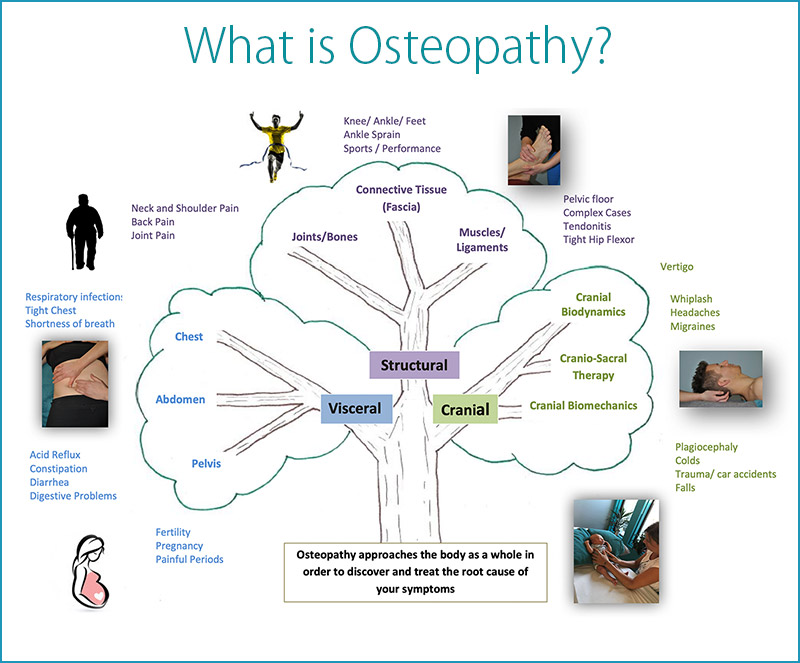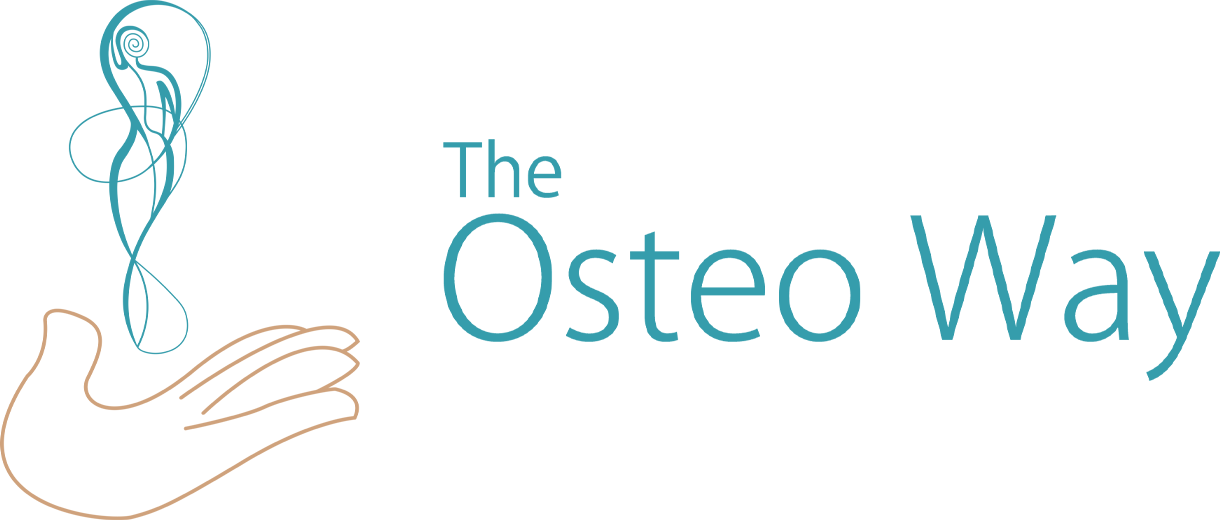Osteopathy is a manual therapy that considers the body as a whole in order to prevent, diagnose, and treat dysfunctions in the body. It involves all structures composing the body, and helps restore the body’s healthy state.
Osteopathy takes into account the different connections between the systems composing your body: anatomical, physiological, psychological, and environmental. For example, the loss of mobility of a joint, a muscle, a ligament, or the viscera, can create symptoms elsewhere in the body. An understanding of “the map” of the body through anatomy is essential in finding the root cause.
Shown visually, we can think of it like this: (click to enlarge the diagram)

It is the job of the Osteopathic manual therapist to find the cause of the patient’s symptoms: it is often not located where we feel the pain.
“To find health should be the object of the physician. Anyone can find disease”
-Dr. Andrew Taylor Still, Founder of Osteopathy
Think about your car, when the light bulb of the battery sign comes on, you’re not going to ask your mechanic to turn it off! You’ll pop the hood and change the battery. The human body works in a very similar way, the light bulb is the pain, but it just tells you there is something wrong, but not where. This is the work of an Osteopathic manual therapist: finding the cause.
“An osteopath is only a human engineer, who should understand all the laws governing his engine and thereby master disease.”
-Dr. Andrew Taylor Still, Founder of Osteopathy
Osteopathy allows patients to take care of their inherent health capital, by using the natural capacity of the body to heal, and be healthy, after all we are all Healthy by Nature.
The body is made to make us pain free, and energy efficient. It will shift different structures, to achieve that, until it’s out of solutions, which will lead to pain, tiredness, and not functioning at 100%. We work to find these adaptations, and see which one you need, from the unnecessary ones.
Osteopathy can’t be defined by its techniques, but by the concepts it uses.
Osteopathy is not about using specific protocols. Instead, each patient is considered a unique individual with their own history and personal adaptations. Indeed, at every appointment we will look at you from head to toe, and access what your body needs at that particular time.
Where does Osteopathy come from?
At the end of the 1800s, a military doctor named Andrew Taylor Still, living in Missouri (USA), suffered the loss of three of his children to meningitis. Devastated, he used his energy to create something good, and tried to find a new way to help his patients through the study of anatomy at first and, then, applying it to treat patients with hands-on techniques instead of resorting to using drugs.
His career as an Osteopath really started when he treated a child with dysentery only using his hands in 1874. The same year a new alternative medicine was born with a better understanding of the natural law of life and nature. The first school was funded in 1892 in Kiksville MI.
Osteopathic Principles
At its core, the practice of Osteopathy is based on these underlying principles:
The human body functions as one unit
Our body has an external envelope: the skin. But inside, everything is connected and is dependent on other parts. We are a biological and emotional unit, and a disturbance of one part of the body will have consequences on the whole body.
The structure of the body and function of the body are reciprocally related
For example, a wheel has two parts: a tire and a rim–that’s it’s structure. Its function is to roll and support the car, but if the tire is deflated, the wheel won’t be able to do its job properly. The Osteopathic manual therapist’s job is to find out why the tire is deflated so that she can treat you and you are then able to keep going.
Where the structure of the body is harmonious and normal, disease cannot exist. The proper functioning of the body is related to the integrity of the structure that supports it, and thus each part of the body is linked to the other.

Homeostasis / “Healthy By Nature”
This is the natural capacity of the body to keep all its physiological levels optimal by way of a self-regulatory system that keeps us healthy. An Osteopathic therapist can help the body’s inherent capacity to create self-defence substances.
The human body is designed to be pain-free and energy efficient. In order to achieve that, the body creates adaptations throughout the itself, but when the body is out of solutions, pain happens that doesn’t seem to get better over time. For example: when you sprain your ankle, you’re going to naturally shift your body weight to the opposite side without thinking about it, your pelvis will adjust, and all the vertebrae above will too. But if any previous injuries or a cold are in the way of this, for example, the ankle will take a long time to heal and become stable again.
The role of the artery is absolute
The flow of the blood, lymphatics, and cerebrospinal fluid carries the proper nutrition for the body, removes its waste products, and defends it from infection.
The vessels in our body can be compared to a water hose: if we close the tap, then there is no water; the lack of blood supply will cause the tissue to die (“necrosis”). A knot in the hose can be compared to cholesterol that prevents the blood from circulating freely. Also, when the “debit” of water is too strong within the hose, hypertension can create many symptoms such as ringing in the ears (“tinnitus”).
These are the main principles Osteopathy is founded on. When you visit us, along with treating you, we will try to help you understand what is going on with your body, physiologically, so that you can understand where the hose is getting kinked up in your particular case.
